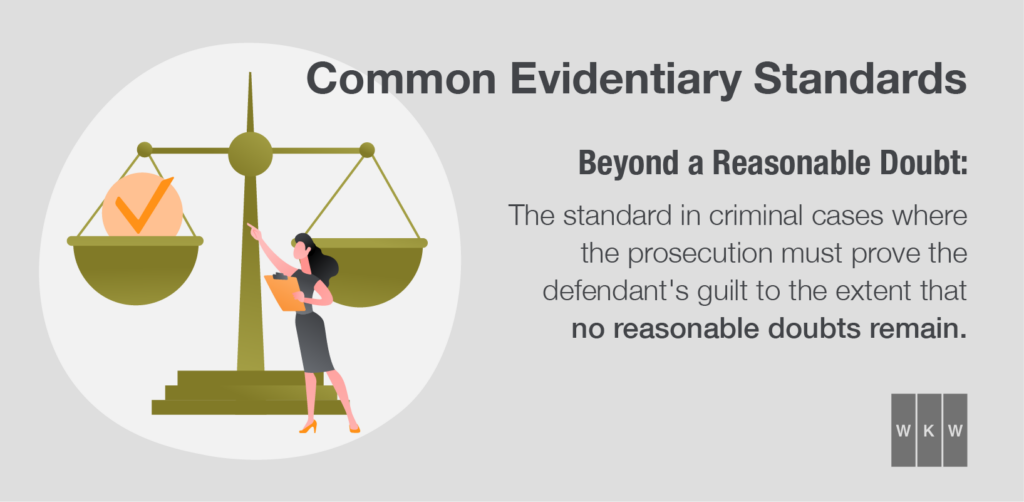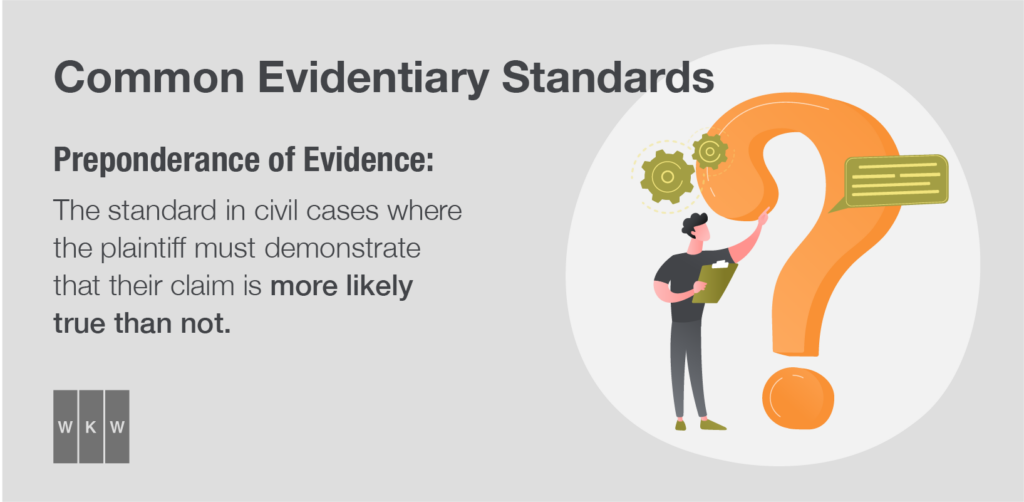Preponderance of Evidence: What to Know
Updated October 30, 2024 | By Emily Chimenti
If your personal injury case heads to trial, you may wonder how the court will decide if the defendant is to blame. In civil cases, like personal injury, the court uses the preponderance of evidence to determine fault. Read on to learn what preponderance of evidence is and when it applies.
What Is Preponderance of Evidence?
A preponderance of evidence is an evidentiary standard a plaintiff must meet in a civil lawsuit to determine whether they will succeed at trial. A plaintiff can establish a preponderance of evidence by showing their explanation of events is more likely to be true than the defendants. For example, in a personal injury case, the plaintiff must explain how the defendant’s action (or inaction) directly caused their injury. The evidence must illustrate how their explanation of events is more likely than the defendant’s.
To better understand this term, we need to break down some other important concepts, such as the burden of proof and evidentiary standard.
What Is the Burden of Proof?
In a lawsuit, one party carries the burden of proof. This party is responsible for gathering and presenting evidence against the other party. In a civil trial, the victim (and their attorney) bears the burden of proof. To get a ruling in their favor, the victim must show evidence that the defendant is guilty.
For example, suppose someone is the victim of medical malpractice. They want to pursue a claim against their primary care doctor for a misdiagnosis. The burden of proof is on the victim. They need to provide medical records and other documentation demonstrating the doctor acted negligently.
Evidentiary Standards
How much proof does the victim need for the judge to rule on their behalf? The evidentiary standard refers to the minimum amount of evidence required to make a judgment. This standard differs between different areas of law. Two common standards are beyond a reasonable doubt and preponderance of evidence.
In a murder case, for example, the prosecutor must provide evidence of the defendant’s guilt beyond a reasonable doubt. The prosecutor must counter any evidence to the contrary so that no other explanation exists.
On the other hand, in a personal injury case, the victim does not need to prove liability beyond a reasonable doubt. They must prove that their version of events is more likely than the defendant’s version. This is a lower standard.
By contrasting these standards, we can better understand the preponderance of evidence.

Beyond a Reasonable Doubt
If you watch legal thrillers or true-crime shows, you’re likely familiar with the phrase “beyond a reasonable doubt.” The prosecutor must provide evidence to support their claim in a criminal case. They need to persuade the judge and jury that the defendant committed the crime, and they must prove it beyond a reasonable doubt.
Beyond a reasonable doubt is the strictest evidentiary standard. If the jury has any reasonable doubt the defendant committed the crime, the prosecutor has not met this standard.

Preponderance of Evidence
Personal injury cases are civil cases, so they have different evidentiary standards than criminal cases. In a personal injury lawsuit, the plaintiff has to demonstrate there is at least a 51% chance the defendant is at fault. If there is an equal likelihood that both parties are correct, the plaintiff has not met the burden of proof, and the jury must side with the defendant.
For example, suppose someone claims they were injured due to another driver’s negligence. They claim the defendant ran a red light, causing their collision. Since the plaintiff needs to prove their claim, they need to establish a preponderance of evidence.
They could present the following:
- Photos from a red light camera showing the defendant in the intersection
- Testimony from the police officer who investigated the collision
- Eyewitness testimony
- Medical records describing the plaintiff’s injury
The defendant may present his own evidence. However, if the jury believes the plaintiff’s evidence is more convincing, they can rule in favor of the plaintiff. The plaintiff does not have to prove beyond a reasonable doubt that the defendant is to blame. Suppose in the red light example, the defendant presented conflicting eyewitness testimony. This testimony sheds some doubt on the defendant’s explanation of events. But overall, there is more evidence for the plaintiff. The medical records, police testimony, and photo evidence strongly favor the plaintiff. In this case, the plaintiff has met the burden of proof, and the preponderance of evidence falls in their favor. The concept of preponderance of evidence plays a crucial and determining role in the outcome of this trial. The majority of the evidence must be in favor of the plaintiff in order for them to win their case.
Contact a Personal Injury Attorney Now
If another party caused you injury due to negligence, contact a personal injury attorney as soon as possible. The attorneys at WKW can review your case and help you gather the necessary evidence to pursue a claim. Contact us today for a free consultation.
Contact Us
Let WKW put our experience to work for you. Contact us for your free case evaluation.
Or, call us today at (317) 920-6400


